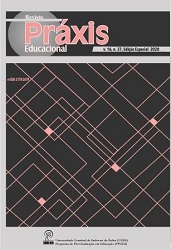REACHING CONSENSUS: A SCOPING REVIEW ON SCHOOL-BASED COMPREHENSIVE SEXUALITY EDUCATION PROGRAMS (CSE)
DOI:
https://doi.org/10.22481/praxisedu.v16i37.6175Keywords:
Scoping review, Comprehensive Sexuality Education, School-based, YouthAbstract
Sexuality education in schools is a hot topic in part because it is closely intertwined with social and parental interpretations of right and wrong. This study is a scoping review that was conducted in six steps: (1) identification of the research question, (2) identification of relevant studies, (3) selection of studies, (4) data extraction, (5) summarizing and reporting the results, and (6) consultation with stakeholders. Curricula were assessed by the Curriculum Evaluation Tool (SIECUS) and guidelines were evaluated by the appraisal of guidelines for research & evaluation (AGREE II) tool. After reviewing 24 programs extracted from 50 studies, the majority of which (90%) were designed and utilized in developing countries, 5 questions were answered. Finally, the “Guidelines for the Sexual Health education component of Comprehensive Health Education” guideline, and the “FLEHI, WSWM, Tuko Pamoja” curricula were recommended with modifications. This review shows that CSE programs are not only cost-effective interventions, but also part of adolescents’ sexual rights. At the beginning of the program, there may be many social and cultural barriers in developing countries, but once a rigorous culturally based program is designed successful results can be achieved. Therefore, designing such programs based on the Iranian culture is strongly recommended.
Downloads
Metrics
References
Adolescent Health Research Priorities: Report of a Technical Consultation. Geneva: World Health Organization. 2015.
Apter, D. (2011). Recent developments and consequences of sexuality education in Finland. Paper presented at the FORUM Sexuality Education and Family Planning.
Behague, S., Christenson, K., Martin, S., Wysong, M., & Kibusu, K. (2006). Tuko Pamoja: adolescent reproductive health and life skills curriculum.
Berkowitz, M. W., & Bier, M. C. (2007). What works in character education. Journal of Research in Character Education, 5(1), 29.
Berne, L., Huberman, B., & Alford, S. (1999). European approaches to adolescent sexual behavior and responsibility: executive summary and call to action. Washington, DC: Advocates for Youth.
Chandra-Mouli, V., Plesons, M., Hadi, S., Baig, Q., & Lang, I. (2018). Building support for adolescent sexuality and reproductive health education and responding to resistance in conservative contexts: Cases from Pakistan. Global Health: Science and Practice, 6(1), 128-136.
Chin, H. B., Sipe, T. A., Elder, R., Mercer, S. L., Chattopadhyay, S. K., Jacob, V., . . . Griffith, M. (2012). The effectiveness of group-based comprehensive risk-reduction and abstinence education interventions to prevent or reduce the risk of adolescent pregnancy, human immunodeficiency virus, and sexually transmitted infections: two systematic reviews for the Guide to Community Preventive Services. American journal of preventive medicine, 42(3), 272-294.
Collins, C., Alagiri, P., Summers, T., & Morin, S. F. (2002). Abstinence only vs. comprehensive sex education: What are the arguments? What is the evidence?
Consortium, A. N. S. (2009). Appraisal of guidelines for research and evaluation II instrument. Retrieved May, 12, 2011.
Farahani, F. K. A., Shah, I., Cleland, J., & Mohammadi, M. R. (2012). Adolescent males and young females in Tehran: differing perspectives, behaviors and needs for reproductive health and implications for gender sensitive interventions. Journal of Reproduction & Infertility, 13(2), 101.
Fonner, V. A., Armstrong, K. S., Kennedy, C. E., O'Reilly, K. R., & Sweat, M. D. (2014). School Based Sex Education and HIV Prevention in Low- and Middle-Income Countries: A Systematic Review and Meta-Analysis. PloS one, 9(3), e89692. doi: 10.1371/journal.pone.0089692
Haruna, H., Hu, X., & Chu, S. K. W. (2018). Adolescent School-Based Sexual Health Education and Training: A Literature Review on Teaching and Learning Strategies. Glob. J. Health Sci, 10, 172. http://www.actionhealthinc.org/publication/. . https://portal.ct.gov/.../Sexual-Health...Health.../Sexual-Health-Education- Curriculum-Framework.
Huaynoca, S., Chandra-Mouli, V., Yaqub Jr, N., & Denno, D. M. (2014). Scaling up comprehensive sexuality education in Nigeria: from national policy to nationwide application. Sex Education, 14(2), 191-209. doi: 10.1080/14681811.2013.856292
Information, S., & States, E. C. o. t. U. (2004). Guidelines for comprehensive sexuality education: Kindergarten-12th grade: Author New York.
Initiative, F. o. S. E. (2012). National sexuality education standards: Core content and skills, K-12 [a special publication of the Journal of School Health]. Retrieved May 23 2014 from.
Kirby, D. (2002). The impact of schools and school programs upon adolescent sexual behavior. Journal of sex research, 39(1), 27-33.
Kirby, D., & Laris, B. (2009). Effective curriculum‐based sex and STD/HIV education programs for adolescents. Child Development Perspectives, 3(1), 21-29.
Kirby, D. B. (2008). The impact of abstinence and comprehensive sex and STD/HIV education programs on adolescent sexual behavior. Sexuality Research & Social Policy, 5(3), 18.
Kirby, D. B., Laris, B., & Rolleri, L. A. (2007). Sex and HIV education programs: their impact on sexual behaviors of young people throughout the world. Journal of Adolescent Health, 40(3), 206-217.
Kivela, J., Haldre, K., Part, K., Ketting, E., & Baltussen, R. (2014). Impact and cost-effectiveness analysis of the national school-based sexuality education programme in Estonia. Sex Education, 14(1), 1-13.
Kivela, J., Ketting, E., & Baltussen, R. (2013). Cost analysis of school-based sexuality education programs in six countries. Cost effectiveness and resource allocation, 11(1), 17.
Levac, D., Colquhoun, H., & O'Brien, K. K. (2010). Scoping studies: advancing the methodology. Implementation science, 5(1), 69.
Lima, D. K. S., Schoeller, S. D., da Silva Knihs, N., Vargas, C. P., Tholl, A. D., Lopes, S. G. R., . . . de Almeida Hammerschmidt, K. S. (2017). Protocol for a scoping review of skin self-care of people with spinal cord injury. BMJ open, 7(9), e017860.
Mathews, C., Aarø, L., Grimsrud, A., Flisher, A., Kaaya, S., Onya, H., . . . Klepp, K.-I. (2012). Effects of the SATZ teacher-led school HIV prevention programmes on adolescent sexual behaviour: cluster randomised controlled trials in three sub-Saharan African sites. International Health, 4(2), 111-122.
Mohammadi, M. R., Mohammad, K., Farahani, F. K., Alikhani, S., Zare, M., Tehrani, F. R., . . . Alaeddini, F. (2006). Reproductive knowledge, attitudes and behavior among adolescent males in Tehran, Iran. International family planning perspectives, 35-44.
Organization, W. H. (2017). Adolescent health research priorities: report of a technical consultation, WHO reference number: WHO: FWC/MCA/15/07.
Rijsdijk, L. E., Bos, A. E., Ruiter, R. A., Leerlooijer, J. N., de Haas, B., & Schaalma, H. P. (2011). The World Starts With Me: A multilevel evaluation of a comprehensive sex education programme targeting adolescents in Uganda. BMC public health, 11(1), 334.
Roy, S., Roy, S., & Rangari, K. (2007). Comprehensive health care including sexual and reproductive health of adolescents and youths is of vital importance to the nation. Health and Population-Perspectives and Issues, 30(4), 243-267.
Sajjadi, M., Moshki, M., Abasnezhad, A., & Bahri, N. (2012). Educational needs of fathers about boys puberty period and its related factors. Zahedan Journal of Research in Medical Sciences, 14(2), 66-70.
Samadaee-Gelehkolaee, K., McCarthy, B. W., Khalilian, A., Hamzehgardeshi, Z., Peyvandi, S., Elyasi, F., & Shahidi, M. (2016). Factors Associated With Marital Satisfaction in Infertile Couple: A Comprehensive Literature Review. Global journal of health science, 8(5), 96.
Schutte, L., Meertens, R. M., Mevissen, F. E., Schaalma, H., Meijer, S., & Kok, G. (2014). Long Live Love. The implementation of a school-based sex-education program in the Netherlands. Health education research, 29(4), 583-597.
Stanger-Hall, K. F., & Hall, D. W. (2011). Abstinence-only education and teen pregnancy rates: why we need comprehensive sex education in the US. PloS one, 6(10), e24658.
Udegbe, B. I., Fayehun, F., Isiugo-Abanihe, U. C., Nwagwu, W., Isiugo-Abanihe, I., & Nwokocha, E. (2015). Evaluation of the implementation of family life and HIV education programme in Nigeria. African journal of reproductive health, 19(2), 79-92.
UNFPA. (2014). Operational Guidance for Comprehensive Sexuality Education: A Focus on Human Rights and Gender: UNFPA New York.
Wight, D., & Buston, K. (2003). Meeting needs but not changing goals: evaluation of in-service teacher training for sex education. Oxford Review of Education, 29(4), 521-543.
Wolfe, D. A., Crooks, C., Jaffe, P., Chiodo, D., Hughes, R., Ellis, W., . . . Donner, A. (2009). A school-based program to prevent adolescent dating violence: A cluster randomized trial. Archives of pediatrics & adolescent medicine, 163(8), 692-699.
Women, U., & UNICEF. (2018). International technical guidance on sexuality education: an evidence-informed approach: UNESCO Publishing.
www.behdasht.gov.ir/index.aspx?siteid=1&pageid=156.
Zare, E., Simbar, M., Shahhosseini, Z., & Alavi Majd, H. (2017a). The Priorities of Iranian Male Adolescents Health Needs. American Journal of Men's Health, 1557988317693346.
Zare, E., Simbar, M., Shahhosseini, Z., & Alavi Majd, H. (2017b). The Priorities of Iranian Male Adolescents Health Needs. American Journal of Men's Health, 11(4), 1255-1259.
Downloads
Published
How to Cite
Issue
Section
License
You are free to:
Share - copy and redistribute the material in any medium or format; Adapt - remix, transform, and build from the material for any purpose, even commercially. This license is acceptable for Free Cultural Works. The licensor cannot revoke these freedoms as long as you follow the terms of the license.
Under the following terms:
Attribution - You must appropriately give credit, provide a link to the license, and indicate if any changes have been made. You may do so in any reasonable way, but not in a way that suggests that you or your use is endorsed by the licensor.
There are no additional restrictions - You cannot apply legal terms or technological measures that legally restrict others to make any use permitted by the license.










